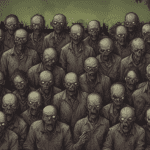The Supreme Court declined to hear five same-sex marriage cases on Monday, thus opening the door to the expansion of marriage rights into 30 states. For supporters the decision represents an unequivocal victory for equality, while for critics, this “redefinition of marriage” marks a dismaying shift away from tradition. But this latest decision is simply a variation on a theme, continuing another chapter in the nation’s centuries-old argument over the definition of marriage.
In her latest book, Leslie J. Harris, Associate Professor of Communication at the University of Wisconsin, Milwaukee, surveyed five types of 19th-century marriage controversy: domestic violence, divorce, polygamy, free love, and miscegenation. RD spoke with Harris about her project and what it reveals about our contemporary attempts to define, and redefine, marriage.
Your book is concerned with nineteenth century marriage controversies, so same-sex marriage is seldom mentioned. But it was on my mind the whole time I was reading. Did it inspire or influence your writing in any way?
Yes, the same-sex marriage controversy was an important factor in inspiring the book. I’ve been very interested in the issue for years, but I was particularly intrigued by the rash of state constitutional amendments in the early 2000s. I couldn’t help but wonder why marriage mattered so deeply to so many people.
For those advocating the amendments, marriage seemed to function as a status and idea that was much larger than any particular relationship. War metaphors were common as advocates declared that marriage was “under attack” and needed to be “defended,” and marriage was commonly represented as a sacred and unchangeable institution. While the other side of the debate emphasized the huge number of laws and policies tied to marriage, simply changing laws and policies quickly became an inadequate response. Marriage seemed to function as a status that enabled full citizenship, and advocates often made the analogy to nineteenth and early twentieth-century bans on interracial marriage.
By examining the history of these controversies we can better understand what is at stake today. In the nineteenth century the topic of marriage arose in almost every major controversy of the time including women’s rights, westward expansion, slavery, immigration, religious diversity, temperance, and state’s rights. Marriage functioned as a lens through which complex issues of belonging, identity, and status were debated.
I’ve become convinced that today’s debate about same-sex marriage is not simply about preserving a seemingly sacred and unchanging institution, or securing particular rights and privileges. Rather, it is about negotiating the boundaries of American-ness. I reference the recent Supreme Court decisions about marriage in the book’s conclusion because they illustrate this point well.
The court said that marriage enables “pride” and “dignity,” especially in reference to raising children (who were said to be humiliated by DOMA). Even as the Supreme Court seemed to open space for same-sex marriage, it (perhaps inadvertently) limited the acceptable gay family to one that models the traditional nuclear family.
Read the rest here















